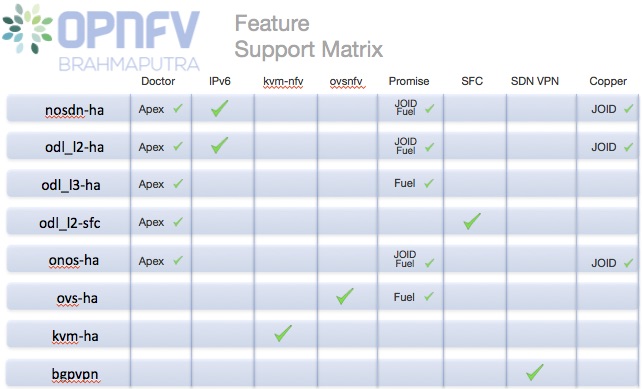Overview¶
OPNFV provides a variety of virtual infrastructure deployments designed to host virtualised network functions (VNFs). This guide intends to help users of the platform leverage the features and capabilities delivered by the OPNFV project.
OPNFV Continuous Integration builds, deploys and tests combinations of virtual infrastructure components in what are defined as scenarios. A scenario may include components such as OpenStack, OpenDaylight, OVS, KVM etc. where each scenario will include different source components or configurations. Scenarios are designed to enable specific features and capabilities in the platform that can be leveraged by the OPNFV user community.
OPNFV Features¶
Each OPNFV scenario provides unique features and capabilities, it is important to ensure you have a scenario deployed on your infrastructure that provides the right capabilities for your needs before working through the user guide.
This user guide outlines how to work with key components and features in the platform, each feature description section will indicate the scenarios that provide the components and configurations required to use it.
Each scenario provides a set of platform capabilities and features that it supports. It is possible to identify which features are provided by reviewing the scenario name, however not all features and capabilities are discernible from the name itself.
Brahmaputra feature support matrix¶
The following table provides an overview of the available scenarios and supported features in the Brahmaputra release of OPNFV.

The table above provides an overview of which scenarios will support certain feature capabilities. The table does not indicate if the feature or scenario has limitations. Refer to the Configuration Guide for details on the state of each scenario and further information.
Feature development in the Brahmaputra release often consisted of the development of specific requirements and the further integration and validation of those requirements. This results in some features only being supported on the platform when a specific scenario, providing the capabilities necessary to run the feature, is deployed.
Scenario Naming¶
In OPNFV, scenarios are identified by short scenario names. These names follow a scheme that identifies the key components and behaviours of the scenario, the rules for scenario naming are as follows:
os-[controller]-[feature]-[mode]-[option]
For example: os-nosdn-kvm-noha provides an OpenStack based deployment using neutron including the OPNFV enhanced KVM hypervisor.
The [feature] tag in the scenario name describes the main feature provided by the scenario. This scenario may also provide support for features, such as advanced fault management, which are not apparent in the scenario name. The following section describes the features available in each scenario.
For details on which scenarios are best for you and how to install and configure them on your infrastructure the OPNFV Configuration Guide provides a valuable reference.
The user guide will describe how to enable and utilise features and use cases implemented and tested on deployed OPNFV scenarios. For details of the use cases and tests that have been run you should check the validation procedures section of the OPNFV Configuration Guide. This will provide information about the specific use cases that have been validated and are working on your deployment.
General usage guidelines¶
The user guide for OPNFV features and capabilities provide step by step instructions for using features that have been configured according to the installation and configuration instructions.
This guide is structured in a manner that will provide usage instructions for each feature in its own section. Start by identifying the feature capability you would like to leverage, then read through the relevant user guide section to understand how to work with the feature. The combination of platform features, if available in a given scenario and not otherwise indicated, should operate according to the documentation. Dependencies between features will be highlighted in the user guide text.
You may wish to use the platform in a manner that the development teams have not foreseen, or exercise capabilities not fully validated on the platform. If you experience issues leveraging the platform for the uses you have envisioned, the OPNFV user mailing list provides a mechanism to establish a dialog with the community to help you overcome any issues identified.
It may be that you have identified a bug in the system, or that you are trying to execute a use case that has not yet been implemented. In either case it is important for OPNFV to learn about it as we are in essence a development project looking to ensure the required capabilities for our users are available.
